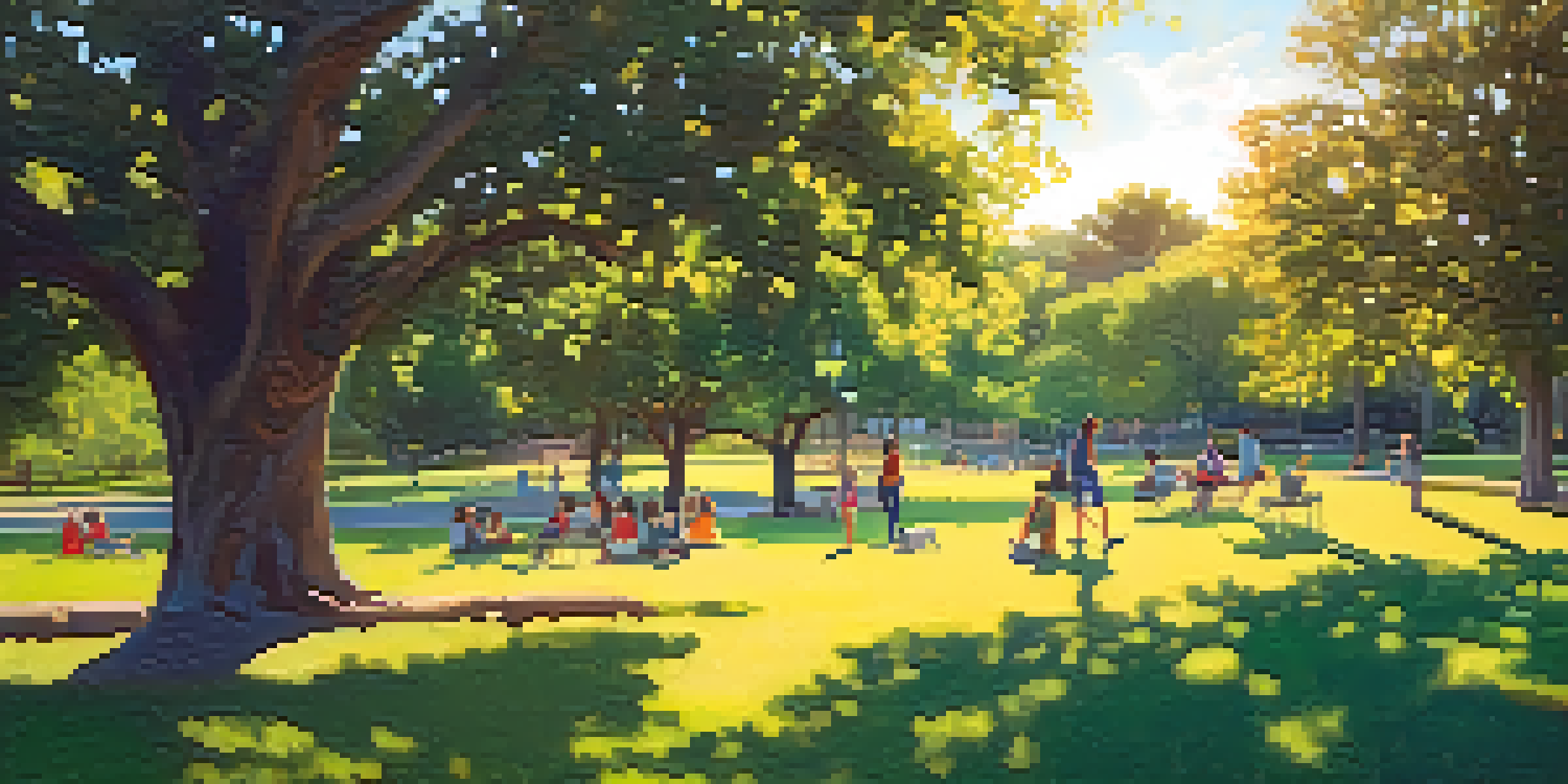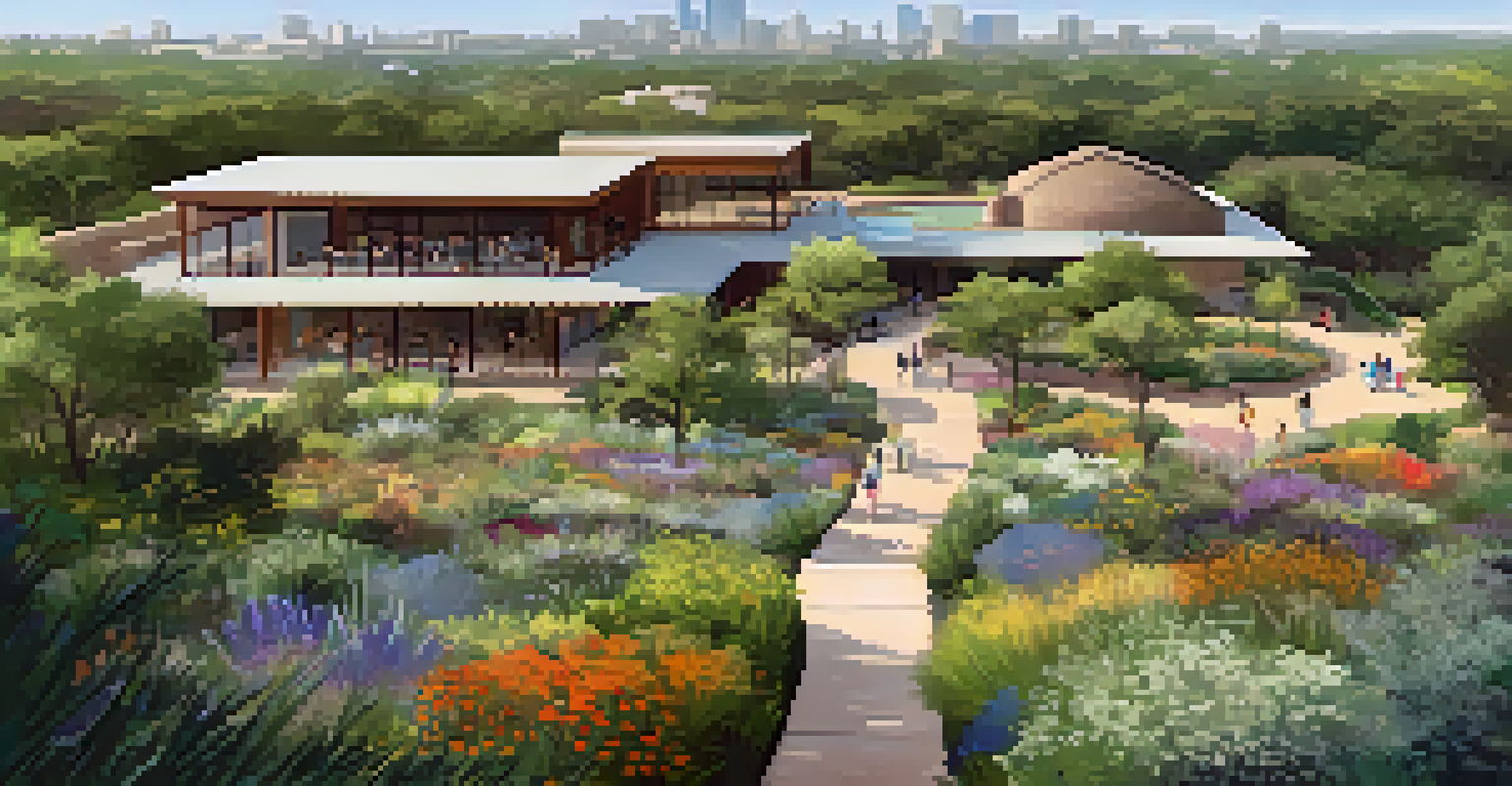The Future of Green Spaces in Austin's Urban Areas

Understanding the Importance of Green Spaces in Urban Areas
Green spaces are vital in urban areas as they provide numerous benefits, including improving air quality, enhancing mental health, and creating community gathering spots. In bustling cities like Austin, these natural areas serve as a refuge from the concrete jungle, offering a breath of fresh air amid the hustle and bustle. As urban populations grow, the need for accessible green spaces becomes even more critical.
Green spaces are not just a luxury; they are essential for the health and well-being of our urban environments.
Beyond aesthetics, studies have shown that green spaces contribute to lower crime rates and increased property values, making them an essential part of urban planning. They act as social equalizers, providing everyone, regardless of background, a place to connect with nature and each other. This underscores the need for cities like Austin to prioritize the integration of green spaces into their development strategies.
In essence, green spaces are not just nice to have; they are essential for creating healthier, happier urban environments. As we look toward the future, it’s crucial to recognize their multifaceted role in enhancing the quality of life for all residents.
Current State of Green Spaces in Austin
Austin, known for its vibrant culture and outdoor lifestyle, has made significant strides in incorporating green spaces into its urban framework. Parks like Zilker Park and the Lady Bird Johnson Wildflower Center showcase the city’s commitment to preserving nature amidst urban development. However, with a growing population, these spaces are under increasing pressure to meet the needs of a diverse and expanding community.

The city's existing green spaces face challenges such as overcrowding, maintenance issues, and the encroachment of urban development. As more people flock to Austin for its unique charm, the demand for well-maintained parks and recreational areas continues to rise. Addressing these challenges is essential to ensuring that green spaces remain accessible and enjoyable for everyone.
Green Spaces Boost Urban Well-Being
Green spaces improve air quality, enhance mental health, and foster community connections in urban areas.
Moreover, the disparity in access to green spaces among different neighborhoods highlights the need for more equitable distribution. Some areas of Austin enjoy abundant green spaces, while others lack basic access, leading to a conversation about how to create a more inclusive urban landscape.
The Role of Technology in Enhancing Green Spaces
Technology is playing an increasingly crucial role in the future of urban green spaces. Innovations such as smart irrigation systems and drone monitoring are helping cities like Austin maintain and optimize their parks. These technologies not only ensure that green spaces are healthy and sustainable but also enhance the user experience by providing real-time data on park conditions.
The best way to predict the future is to create it.
Additionally, apps and platforms that promote community engagement are fostering a deeper connection between residents and their local green spaces. For instance, platforms that allow users to report maintenance issues or suggest improvements enable community members to take an active role in caring for their parks. This collaborative approach not only maintains the spaces but also strengthens community bonds.
As technology continues to evolve, we can expect even more innovative solutions to enhance the functionality and accessibility of green spaces. From virtual reality experiences that allow residents to visualize new park designs to data-driven approaches for urban planning, the future of green spaces in Austin is set to become more interactive and engaging.
Community Involvement in Green Space Development
Community involvement is essential for the successful development and maintenance of green spaces in Austin. Local organizations and residents often lead initiatives to create and enhance parks, ensuring these spaces reflect the needs and desires of the community. By collaborating with city planners, residents can influence the design and functionality of their local green areas.
Participatory design processes, where community members are invited to share their ideas and feedback, can result in more meaningful and diverse green spaces. Events like community workshops and park clean-up days not only foster a sense of ownership but also educate residents about the importance of preserving these natural areas. This active participation can lead to a more vibrant and well-loved urban landscape.
Tech Enhances Urban Green Spaces
Innovative technologies are optimizing the maintenance and user experience of parks in cities like Austin.
Moreover, engaging youth in green space projects can inspire the next generation to value and protect their environment. By involving schools and youth organizations, cities can cultivate a culture of stewardship that benefits both the community and the green spaces themselves.
Sustainability Practices for Future Green Spaces
Sustainability is at the forefront of urban planning, and Austin is no exception. Future green spaces are expected to integrate eco-friendly practices, such as native plant landscaping, rainwater harvesting, and sustainable materials. These practices not only reduce the environmental footprint of parks but also create habitats for local wildlife, fostering biodiversity in urban settings.
Implementing these sustainable practices can also educate the community about environmental stewardship. For instance, community gardens and urban farms can serve as hands-on learning opportunities for residents, teaching them about sustainable agriculture and healthy eating. By incorporating educational elements, green spaces can become vital resources for promoting ecological awareness and responsible living.
Furthermore, sustainability in green spaces can lead to long-term cost savings for cities. By investing in environmentally-friendly infrastructure, Austin can reduce maintenance costs and enhance the resilience of its parks against climate change impacts.
Addressing Climate Change Through Urban Green Spaces
Urban green spaces play a pivotal role in combating climate change, particularly in cities like Austin that are experiencing rapid growth. Trees and plants help absorb carbon dioxide, mitigate heat, and improve air quality, making them invaluable assets in the fight against climate change. As temperatures rise, the importance of these natural areas becomes even more pronounced, creating cooler microclimates within urban environments.
Additionally, green spaces can reduce stormwater runoff, lowering the risk of flooding and protecting local waterways. By incorporating features like rain gardens and permeable pavements, cities can enhance their resilience to extreme weather events while also improving water quality. This dual benefit highlights how green spaces can proactively address climate challenges.
Community Engagement is Key
Active participation from residents leads to more meaningful and well-maintained green spaces that reflect community needs.
As Austin continues to develop, integrating climate-conscious designs into green spaces will be essential. By prioritizing these areas in urban planning, the city can create a more sustainable and livable environment for current and future residents.
Looking Ahead: The Vision for Austin's Green Spaces
The future of green spaces in Austin is bright, with a vision that prioritizes accessibility, sustainability, and community engagement. As urban areas continue to expand, city planners and residents alike are recognizing the importance of integrating more parks and green areas into the urban fabric. This forward-thinking approach aims to create a city where nature and urban life coexist harmoniously.
Key initiatives, such as the Austin Strategic Mobility Plan and the Urban Forest Plan, outline ambitious goals for enhancing green spaces throughout the city. By focusing on equity and access, these plans seek to ensure that every resident can enjoy the benefits of nearby parks and natural areas. Collaborations between the city and community organizations will be vital in achieving these goals.

Ultimately, the vision for Austin's green spaces is about creating a vibrant, inclusive, and resilient urban ecosystem. As we look to the future, the collaborative efforts of city officials, residents, and environmental advocates will shape the green spaces that define Austin's identity.